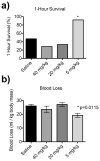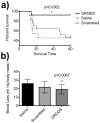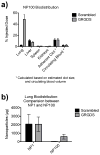Tuning ligand density on intravenous hemostatic nanoparticles dramatically increases survival following blunt trauma
- PMID: 23841817
- PMCID: PMC3758899
- DOI: 10.1021/bm400619v
Tuning ligand density on intravenous hemostatic nanoparticles dramatically increases survival following blunt trauma
Abstract
Targeted nanoparticles are being pursued for a range of medical applications. Here we utilized targeted nanoparticles (synthetic platelets) to halt bleeding in acute trauma. One of the major questions that arises in the field is the role of surface ligand density in targeted nanoparticles' performance. We developed intravenous hemostatic nanoparticles (GRGDS-NP1) and previously demonstrated their ability to reduce bleeding following femoral artery injury and increase survival after lethal liver trauma in the rat. These nanoparticles are made from block copolymers, poly(lactic-co-glycolic acid)-b-poly L-lysine-b-poly(ethylene glycol). Surface-conjugated targeting ligand density can be tightly controlled with this system, and here we investigated the effect of varying density on hemostasis and biodistribution. We increased the targeting peptide (GRGDS) concentration 100-fold (GRGDS-NP100) and undertook an in vitro dose-response study using rotational thromboelastometry, finding that GRGDS-NP100 hemostatic nanoparticles were efficacious at doses at least 10 times lower than the GRGDS-NP1. These results were recapitulated in vivo, demonstrating efficacy at eight-fold lower concentration after lethal liver trauma. 1 h survival increased to 92% compared with a scrambled peptide control, 45% (OR = 14.4, 95% CI = [1.36, 143]), a saline control, 47% (OR = 13.5, 95% CI = [1.42, 125]), and GRGDS-NP1, 80% (OR = 1.30, n.s.). This work demonstrates the impact of changing synthetic platelet ligand density on hemostasis and lays the foundation for methods to determine optimal ligand concentration parameters.
Figures







References
-
- Danhier F, Ansorena E, Silva JM, Coco R, Le Breton A, Preat V. J Control Release. 2012;161(2):505–22. - PubMed
-
- Prabhu P, Patravale V. J Biomed Nanotechnol. 2012;8(6):859–82. - PubMed
-
- Thibault G, Tardif P, Lapalme G. J Pharmacol Exp Ther. 2001;296(3):690–6. - PubMed
-
- Modery CL, Ravikumar M, Wong TL, Dzuricky MJ, Durongkaveroj N, Sen Gupta A. Biomaterials. 2011;32(35):9504–14. - PubMed
Publication types
MeSH terms
Substances
Grants and funding
LinkOut - more resources
Full Text Sources
Other Literature Sources
Medical
Miscellaneous

